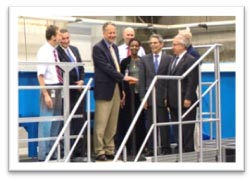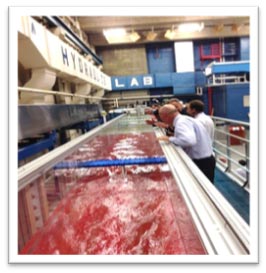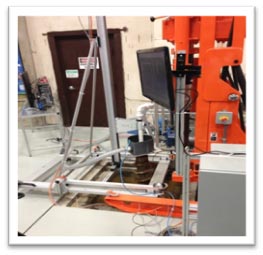U.S. Department of Transportation
Federal Highway Administration
1200 New Jersey Avenue, SE
Washington, DC 20590
202-366-4000
Federal Highway Administration Research and Technology
Coordinating, Developing, and Delivering Highway Transportation Innovations
|
R&T NOW This newsletter is an archived publication and may contain dated technical, contact, and link information. |
|
| Publication Number: N/A Date: September/October 2015 |
Publication Date: September/October 2015
|
PDF files can be viewed with the Acrobat® Reader®
White House OST-P Visits Turner-Fairbank
On August, 6, 2015, Bob Simon, Principal Advisor to the Director for Energy, Transportation, and Resources, at the White House Office of Science & Technology Policy (OST-P), visited FHWA’s Turner-Fairbank Highway Research Center (TFHRC). Simon was briefed by FHWA Associate Administrator Michael Trentacoste and others on FHWA’s Research and Technology Program and visited several of TFHRC’s laboratories that work with asphalt mixtures. Simon also visited the Saxton Transportation Operations Laboratory and viewed a crash test at the Federal Outdoor Impact Lab. The Principal Advisor has a particular interest in advanced research, cutting-edge developments, and the Technology and Innovation Deployment Program, including FHWA’s Every Day Counts Initiative.
For more information, contact Hiwot Abdi, 202-493-3999, hiwot.abdi@dot.gov
Summary Report: The Impact of Automated Transit, Pedestrian, and Bicycling Facilities on Urban Travel Patterns
FHWA’s Exploratory Advanced Research (EAR) Program recently published a report that summarizes an EAR project that examined the effects of automated transit and pedestrian and bicycling facilities on urban travel patterns. The distance between a traveler’s origin or destination and the nearest public transit station is often time-consuming, inconvenient, or unsafe to travel and may discourage potential transit riders from using the system. Known as the “last-mile problem,” this distance impedes full usage of existing transit systems, particularly in outlying suburban and exurban areas.
The project explored the potential of a hypothetical driverless vehicle to improve access to and use of available rapid-transit rail service. Researchers conducted a survey in four metropolitan Chicago neighborhoods served by commuter rail to determine how residents’ travel preferences might change with the potential addition of an automated community shuttle service to and from the station as well as a package of streetscape improvements to facilitate walking and bicycling to the station. The neighborhoods differed in levels of population density, current rail use, land use, and affluence.
The report is available to download at www.fhwa.dot.gov/advancedresearch/pubs/15015/index.cfm.
Hydraulics Lab Celebrates New Flume System, Holds Open House
On September 1, 2015, FHWA’s J. Sterling Jones Hydraulics Laboratory held an open house at TFHRC to celebrate its new multifunctional flume system, which is expected to advance the lab’s ability to predict flooding-related damages and improve design guidance for mitigating impacts on bridges and other hydraulic structures. The event brought together leadership and staff from FHWA headquarters, including FHWA Executive Director Jeff Paniati, and office directors and researchers from various disciplines. J. Sterling Jones, for whom the lab is named after, also attended the event.
 Executive Director Jeff Paniati pushes the start button on the new flume. |
To display how the new flume operates and mark the beginning of the Hydraulics Research Program’s strategic vision, the Executive Director pushed the system start button, prompting water to flow into the flume and stream beneath a small scale bridge.
Boasting a 90-foot-long and 13-foot-wide tiltable working platform for setting up experiments, the flume system features a 27-foot-long flow inlet headworks, an outlet section, and a sediment recirculating system that is nationally unique.
The recirculating system allows for sediment infeed from the bottom of the flume channel sections. The flume system will support the hydraulics research program’s vision to enhance experimental work and use computational fluid dynamics modeling for a large part of the research.
 Water flows into the flume and streams beneath a small scale bridge. |
The open house also included a demonstration of the lab’s in-situ scour testing device, which is expected to help in assessing the soil erosion resistance at bridge foundation sites. An FHWA Strategic Initiative, the in-situ scour testing device is part of a new bridge scour design methodology that researchers are currently working on in the lab.
 The in-situ scour testing device is part of a new bridge scour design methodology. |
Researchers also demonstrated the lab’s advanced high performance computing capabilities in collaboration with the Argonne National Laboratory and discussed how the multifunctional flume system will support the interaction between experiments in the flume and computer modeling.
The open house concluded with a demonstration of the lab’s three dimensional printing capabilities. Researchers discussed how these capabilities have enhanced the lab’s working environment.
For more information, contact Kornel Kerenyi, 202-493-3142, kornel.kerenyi@dot.gov.
TFHRC Hosts Mini-Seminar on Precast Concrete Pavements
On July 21, 2015, TFHRC hosted a mini-seminar on the state of the practice and applications of precast concrete pavements. Presented by FHWA’s Precast Pavement Implementation Team, the seminar addressed how precast concrete pavement systems are becoming the pavement systems of choice for rapid rehabilitation of high volume roadways in urban and suburban areas where daytime lane closure may be challenging.
The use of precast concrete pavement (PCP) technology can significantly reduce traffic impacts along such roadways and provide longer lasting treatments. Project R05, a study completed in 2012 under the Second Strategic Highway Research Program (SHRP2), demonstrated that PCP technology is ready for wider implementation and that many of the PCP systems available in the United States can meet the needs of highway agencies for rapid renewal of their highway systems. Several highway agencies, including Caltrans, Illinois Tollway, New York State Department of Transportation (DOT), New Jersey DOT, and Utah DOT are routinely using PCP technology for repair as well as corridor-wide pavement rehabilitation and reconstruction. A review of projects constructed in the United States and the SHRP2 field testing indicated that sufficient advances have been made to reliably design and construct PCP systems to achieve five key attributes of successful pavements: constructability, concrete durability, load transfer at joints, panel support, and efficiency.
The mini-seminar offered information on the state of precast concrete pavement technology and an overview discussion on the selection of candidate projects for PCP applications, PCP systems, and PCP applications. The event also featured case studies of PCP use by various agencies.
The SHRP2 Project R05 report, Precast Concrete Pavement Technology, is available at www.trb.org/main/blurbs/167788.aspx.
For more information, contact John Moulden, 202-493-3470, john.moulden@dot.gov..
FHWA National Geotechnical Discipline Team Meets at TFHRC
On July 21 and 22, 2015, members of FHWA’s National Geotechnical Discipline Team conducted an annual business meeting at TFHRC. Hosted by FHWA’s Office of Infrastructures Research and Development Bridge and Foundation Engineering Team, the meeting brought together representatives from the Resource Center, headquarters, and the National Highway Institute. Each office provided an overview of their activities, with discussions focused on research and program needs. The aim of the meeting was to maintain communication, cooperation, and coordination within the discipline and align programs.
It also provided an opportunity for the participants to tour the facility. In addition to a visit to the Geotechnical Laboratory, the tour included a visit to the Hydraulics Laboratory—to learn about the new multifunctional flume system and the in-situ scour testing device—and to the Accelerated Loading Facility test pits, where researchers were working on the Transportation Pooled Fund project, “Standardizing Lightweight Deflectometer Measurements for Quality Assurance and Modulus Determination in Unbound Bases and Subgrades.” Feedback about the meeting was positive and included action items to further develop the discipline and programs within the agency and establish a geotechnical succession plan.
For more information, contact Mike Adams, 202-493-3025, mike.adams@dot.gov.
Article on Lightweight Concrete Recognizes Research at TFHRC
Ben Graybeal, who heads FHWA’s Structural Concrete Research Program, and Gary Greene of Trine University recently published the article, “FHWA LWC Research Leads to LRFD Specification Changes,” in ASPIRE magazine. The article, which appears in the magazine’s Summer 2015 issue, focuses on the extensive research program executed at TFHRC to assess the structural performance of lightweight concrete (LWC) and to assist the American Association of State Highway and Transportation Officials in instituting appropriate revisions to the Load and Resistance Factor Design (LRFD) Bridge Design Specifications.
To read the article, visit www.aspiremagazinebyengineers.com/i/532296-summer-2015.
For more information, contact Ben Graybeal, 202-493-3122, benjamin.graybeal@dot.gov.
Hydraulic Engineering Discipline Meets at TFHRC
FHWA’s annual Hydraulic Engineering Discipline meeting was held August 10–14, 2015 at TFHRC. Hosted by FHWA’s J. Sterling Jones Hydraulics Research Laboratory, the meeting brought together professionals from various offices, including the Headquarters Office of Bridges and Structures, TFHRC, the Resource Center, and the three Federal Lands Highway Divisions. Comprised of 18 members, the Hydraulics Discipline gathers each year to engage in a variety of activities, such as participating in internally led training; addressing design issues and concerns; receiving updates on policy, research, technology development and deployment, and training; and revising the multiyear National Hydraulics Activities Roadmap. Key topics of this year’s meeting included the hydraulic design of bridge abutments and shallow bridge foundations; the design, installation, and quality control of scour countermeasures; and an assessment of climate change and sea level rise impacts on infrastructure.
For information contact Kornel Kerenyi, 202-493-3142, kornel.kerenyi@dot.gov.
Report: Evaluation of LTTP Climatic Data for Use in MEPDG Calibration and Other Pavement Analysis
Improvements in FHWA’s Long-Term Pavement Performance (LTPP) Program’s climate data are needed to support current and future research into climate effects on pavement materials, design, and performance. The calibration and enhancement of the Mechanistic-Empirical Pavement Design Guide (MEPDG) is just one example of these emerging needs.
The report, “Evaluation of LTTP Climatic Data for Use in MEPDG Calibration and Other Pavement Analysis,” includes results of an evaluation of climate data from Modern-Era Retrospective Analysis for Research and Applications (MERRA), which provides continuous hourly weather data starting in 1979 on a relatively fine-grained uniform grid. MERRA is based on a reanalysis model that combines computed model fields (e.g., atmospheric temperatures) with ground-, ocean-, atmospheric-, and satellite-based observations that are distributed irregularly in space and time.
This document includes recommendations for incorporating hourly MERRA data into the LTPP database.The report is available to download at www.fhwa.dot.gov/publications/research/infrastructure/pavements/ltpp/15019/index.cfm.
FHWA Posts Sources Sought Notice to Conduct Market Research
On September 1, 2015, FHWA posted a Sources Sought notice to conduct market research. The notice aimed to determine if there are any small business concerns, educational institutions (historically black colleges and universities) capable of performing certain non-personal services technical support for FHWA’s Office of Safety Research and Development. These services will support research on why traffic crashes occur and help advance science and data driven approaches that can counteract the factors that create a crash.
For more information, contact James Pol, 202-493-3371, james.pol@dot.gov.
Technical Brief: Safety Evaluation of Access Management Policies and Techniques
Access management offers access to land development while preserving the flow of traffic on the surrounding road network for safety, capacity, and speed. Although operational effects of access management have been investigated quantitatively through different modeling and analysis approaches, more scientifically rigorous evaluations are needed. The technical brief, “Safety Evaluation of Access Management Policies and Techniques,” discusses a study to fill research gaps and quantify the safety impacts of corridor access management decisions.
Researchers developed corridor-level crash prediction models to estimate and analyze the safety effects of selected access management techniques for different area types, land uses, roadway variables, and traffic volumes. They collected more than 600 miles of detailed corridor data across four regions of the United States to facilitate the model estimation process.
This technical brief is available to download at www.fhwa.dot.gov/publications/research/safety/15038/index.cfm.
Report: Safety Evaluation of Centerline Plus Shoulder Rumble Strips
As part of its strategic highway safety effort, FHWA organized a pooled fund study of 38 States to evaluate low-cost safety strategies. The report, “Safety Evaluation of Centerline Plus Shoulder Rumble Strips,” discusses research aimed at evaluating the safety effectiveness of several low-cost safety strategies through scientifically rigorous crash-based studies. One of the strategies selected for evaluation was the application of shoulder rumble strips and centerline rumble strips in combination. This strategy is intended to reduce the frequency of crashes by alerting drivers that they are about to leave the travelled lane.
Researchers obtained geometric, traffic, and crash data at treated two-lane rural road locations in Kentucky, Missouri, and Pennsylvania. To account for potential selection bias and regression-to-the-mean, they conducted an Empirical Bayes before-after analysis using reference groups of untreated two-lane rural roads with similar characteristics to the treated sites.
This report is available to download at www.fhwa.dot.gov/publications/research/safety/15048/index.cfm.
FHWA Releases Version 2.2 of RDE and New Connected Vehicle Data Sets
FHWA’s Office of Operations Research and Development has released version 2.2 of the Research Data Exchange (RDE) and new connected vehicle data sets. A Web-based data resource provided by the U.S. Department of Transportation Intelligent Transportation Systems (ITS) Program, the RDE now contains two new data environments associated with intersection queues and weather sensing applications that were demonstrated during the 2014 ITS World Congress. These new data environments include intersection queueing data and situation data based on J2735 messages (queue counts by lane at a downtown intersection; counts of instrumented vehicles in queue at traffic signal phases; videos of queues; vehicle situation data from nine instrumented vehicles; and intersection and traveler situation data from roadside units) and data from a weather sensing and alert demonstration (road weather-related observation data and road weather-related advisory warnings).
The RDE collects, manages, and provides access to archived and real-time multisource and multimodal data to support the development and testing of ITS applications. Features included in the latest release include version control to track updated versions of data; a link to the weather data environment containing road weather data; a graphical and text based search capability across all data environments; and the ability to “like” or promote files with social media.
To explore this resource, visit the RDE Web site at www.its-rde.net.
For more information, contact Gene McHale, 202-493-3275, gene.mchale@dot.gov, or Jon Obenberger, 202-493-3265, jon.obenberger@dot.gov.
Report Available on INFLO Dynamic Speed Harmonization and Queue Warning
The final report, Technical Report on Prototype Intelligent Network Flow Optimization (INFLO) Dynamic Speed Harmonization and Queue Warning, was recently published. The report describes the prototyping, acceptance testing and small-scale demonstration of the INFLO Prototype Speed Harmonization (SPD-HARM) and Queue Warning (Q-WARN) applications. The report also describes programmatic and technical accomplishments of the program. The Small-Scale Demonstration fully confirmed the functionality of the INFLO Prototype System in an operational highway traffic environment.
The document is available at http://ntl.bts.gov/lib/55000/55300/55304/100030614-601_Technical_Report_on_Prototype_Intelligent_Network_Flow_Optimization_Final_.pdf.
For more information, contact Govindarajan Vadakpat, 202-493-3283, g.vadakpat@dot.gov.
Public Roads—July/August 2015
This issue includes: Keeping Virginia Moving; Access for All; Ohio’s Training Gets a Boost; Changing the Landscape of Livability; and How Could a Pile of Dirt Cause a Major Interstate Bridge To Tilt?
It is available online via www.fhwa.dot.gov/publications/publicroads/15julaug/index.cfm.
For more information, contact TaMara McCrae, tamara.mccrae@dot.gov.
Innovator: Accelerating Innovation for the American Driving Experience—September/October 2015
This issue includes: Boost Safety by Going on a Road Diet; GRS-IBS Makes Quick Work of Bridge Replacement; Innovation Results; Alternative Technical Concepts Gain Momentum; Cut Crashes by Targeting Safety Improvements; See Where Innovation Starts; Report Updates Progress on Every Day Counts; States Innovate!; and Events.
The issue is available online via www.fhwa.dot.gov/hfl/innovator/e-version/issue_50/.
Turner-Fairbank Highway Research Center: www.fhwa.dot.gov/research/tfhrc/
Resource Center: www.fhwa.dot.gov/resourcecenter/
National Highway Institute: www.nhi.fhwa.dot.gov/home.aspx
Please forward this newsletter to others you think might find it interesting and/or useful.
Suggestions may be submitted to: FHWA_Now@fhwa.dot.gov